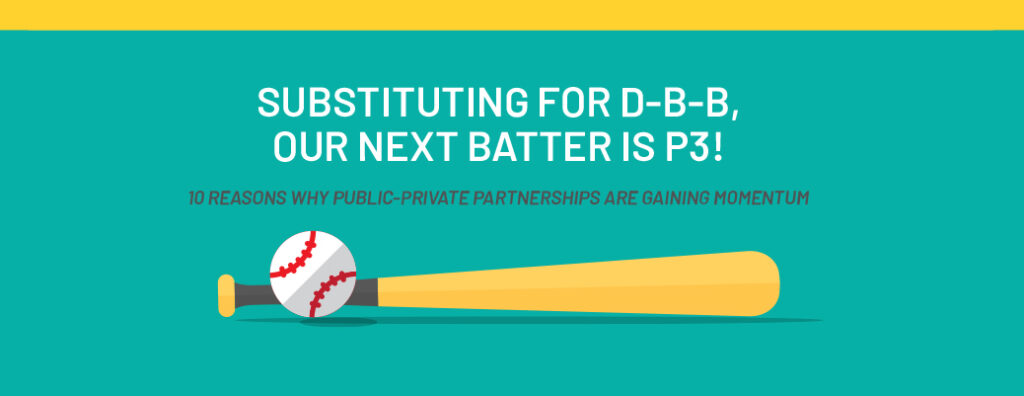
Spring is here, and I am looking forward to Opening Day 2019 and the start of baseball season. As players conduct batting practice, they carefully choose their favorite bat. A lot of thought goes into this selection – the weight, the material, the sound the ball makes coming off of it, how comfortable they are with it, etc. Not unlike baseball players, public owners are becoming more comfortable with using Public-Private Partnerships to deliver their projects.
Public-Private Partnerships (P3)
Also known as PPPs or P3s, Public-Private Partnerships have been utilized in many countries for decades and have gained wide acceptance in the United States since the early 1990s. P3 delivery helps to move development forward by providing an alternative method to finance public capital improvement projects during times when public debt is rapidly increasing. P3 delivery also provides government entities with a means of building or expanding public facilities at a more accelerated pace than if the public agency would solicit bids and award contracts through more traditional procurement methods (e.g. Design-Bid-Build or D-B-B).
Just as baseball stadiums vary in size and features, which impacts how a team plays for their local fans, there are various types of P3s to fit different construction, operation, ownership, and revenue-generating scenarios. We are seeing P3s utilized in transportation, utility infrastructure, and educational facility projects where there are strong tie-ins to the surrounding community. The process is structured to save time and money by providing an alternative approach to the typical public sector design-bid-build project delivery method.
P3 has allowed private entities to acquire, design, construct, improve, renovate, expand, equip, maintain, or operate qualifying projects, as per building codes, and P3 encourages innovative approaches to financing construction and renovation. Over the past decade, the P3 approach has created the needed resources to build a comprehensive range of projects across the country including schools, wastewater treatment plants, and telecommunications infrastructure.
Baseball Managers know that Spring Training is critical for making a run at the World Series. Organizing the talent to perform as a team is critical, so knowing player skills by position gives managers the edge they need for the new season. Likewise, public owners are beginning to better understand the many advantages of using P3 to deliver success.
Advantages of P3 Delivery
- They bring private sector advancements in technology and building practices to the public sector.
- A design-build approach helps to minimize change orders and normally shortens the overall project schedule.
- The project is overseen by a single, integrated entity, which eliminates common discrepancies between the designer and general contractor.
- The merging of public and private entities helps to strengthen the surrounding community by bringing new solutions for infrastructure and facility requirements.
- Alternative financing helps to reduce government debt and makes government funds more readily available for other services and programs.
- Selection in P3 delivery is typically based on qualification and best value – not the lowest bid price – which ensures the project will be executed by the most skilled and experienced team.
- The most common P3 approach is a two-step submittal and review process with public presentation and hearings intermixed along the timeline. This ensures transparency and fairness within the competition.
- The public entity normally has an “off-ramp” (to cancel the P3 solicitation) all the way up to signing the comprehensive agreement with the design-build team.
- P3 fosters an open exchange of ideas between the public and private sectors.
- P3 enhances transparency with public access to the P3 proposals and contracts.
Conclusion
In summary, P3 delivery is a successful proven method for public owners and governmental entities to execute their capital improvement projects. Risk is mitigated for the public owner by normally using the design-build approach within the P3 delivery. Therefore, owner representative firms can provide key value-added services to reduce risk, enhance quality, control costs, and successfully deliver projects for public owners from the conceptual start of a P3 project through project closeout. Let’s get ready to have a great baseball season…Play Ball!
Download a copy of this blog here.
If you are interested in learning more about how P3 delivery can lead to your project’s success, contact us for more information.
Learn more about P3 delivery by visiting additional blogs below:
Summer Road Trips and Public-Private Partnerships
P3 Delivery: Are We Riding the Brake or Pressing the Gas Pedal?
Hot Potato…Who Has the Risk in P3?
Design-Build-Operate P3 Delivery in Sports Facilities for Municipalities




